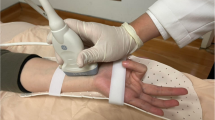Abstract
Increased mechanosensitivity of the median nerve in carpal tunnel syndrome (CTS) has been demonstrated during upper limb tension test 1 (ULTT1) when the nerve is passively elongated. However, the neurophysiological changes of the sensory axons during stressing activities are unknown. The aim of present study was to verify possible changes in the excitability of median nerve afferent axons following nerve stress in elongation, in subjects with and without CTS. Eight CTS hands and eight controls were selected. Recruitment properties of the median nerve were studied by analyzing the relationship between the intensity of electrical stimulation and the size of motor response, before and after intermittent-repetitive neural mobilization. Only in CTS hands, after the intervention, the stimulus–response curve was strikingly abnormal: both plateau and slope values were significantly lower. During anatomical stress across the median nerve in elongation, compressive forces may exert mechanical traction on the median nerve, since it is ‘tethered’ at the carpal tunnel, resulting inactivation of Na+ channels at the wrist, or impairment of energy-dependent processes which affect axonal conduction block. We conclude that in entrapment neuropathies, neural mobilization during nerve elongation may generate conduction failure in peripheral nerve. Our study supports specific considerations for patient education and therapeutic approaches.


Similar content being viewed by others
References
Eliav E, Benoliel R, Tal M (2001) Inflammation with no axonal damage of the rat saphenous nerve trunk induces ectopic discharge and mechanosensitivity in myelinated axons. Neurosci Lett 311:49–52
Bove GM, Ransil BJ, Lin HC, Leem JG (2003) Inflammation induces ectopic mechanical sensitivity in axons of nociceptors innervating deep tissues. J Neurophysiol 90:1949–1955
Dilley A, Lynn B, Pang SJ (2005) Pressure and stretch mechanosensitivity of peripheral nerve fibres following local inflammation of the nerve trunk. Pain 117:462–472
Nee R, Butler D (2006) Management of peripheral neuropathic pain: integrating neurobiology, neurodynamics, and clinical evidence. Phys Ther Sport 7:36–49
Vanti C, Bonfiglioli R, Calabrese M, Marinelli F, Guccione A, Violante FS, Pillastrini P (2011) Upper limb neurodynamic test 1 and symptoms reproduction in carpal tunnel syndrome. A validity study. Man Ther 16:258–263
Lynn B, Greening J, Leary R (2002) Sensory and autonomic function and ultrasound nerve imaging in RSI patients and keyboard workers (No CRR 417/2002). Health and Safety Executive, London
Jaberzadeh S, Zoghi M (2013) Mechanosensitivity of the median nerve in patients with chronic carpal tunnel syndrome. J Bodyw Mov Ther 17:157–164
Sunderland S (1978) Nerves and nerve injuries. Churchill Livingstone, Edinburgh, p 89
Shacklock MO (1995) Neurodynamics. Physiotherapy 81:9–16
Byl C, Puttlitz C, Byl N, Lotz J, Topp K (2002) Strain in the median and ulnar nerves during upper-extremity positioning. J Hand Surg Am 27:1032–1040
Nee RJ, Yang CH, Liang CC, Tseng GF, Coppieters MW (2010) Impact of order of movement on nerve strain and longitudinal excursion: a biomechanical study with implications for neurodynamic test sequencing. Man Ther 15:376–381
Butler D (2005) The neurodynamic techniques. Noigroup Publications, Adelaide City West
American academy of neurology and American academy of physical medicine and rehabilitation (2000) Practice parameter for electrodiagnostic studies in carpal tunnel syndrome: summary statement. Muscle Nerve 25:918–922
Press WH, Flannery BP, Teukolsky SA, Vetterling WT (1986) Numerical recipes Cambridge. Cambridge University Press, UK
Butler DS (2000) The Sensitive nervous system. Noi-group Publications, Adelaide
Ginanneschi F, Mondelli M, Dominici F, Rossi A (2006) Changes in motor axon recruitment in the median nerve in mild carpal tunnel syndrome. Clin Neurophysiol 117:2467–2477
McLellan DL, Swash M (1976) Longitudinal sliding of the median nerve during movements of the upper limb. J Neurol Neurosurg Psychiatry 39:566–570
Matthew C, Kiernan MC, Mogyoros I, Burke D (1999) Conduction block in carpal tunnel syndrome. Brain 122:933–941
Millesi H, Zoch G, Reihsner R (1995) Mechanical properties of peripheral nerves. Clin Orthop Relat Res 314:76–83
Topp KS, Boyd BS (2006) Structure and biomechanics of peripheral nerves: nerve responses to physical stresses and implications for physical therapist practice. Phys Ther 86:92–109
Conflict of interest
This manuscript has not been published before and is not being considered for publication elsewhere. I exclude any financial or other relationships that might lead to a conflict of interest. The authors and any research foundation with which they are affiliated did not receive any financial payments or other benefits from any commercial entity related to the subjects of this article.
Ethical standard
All procedures performed in present study were in accordance with the ethical standards of local research committee and with the 1964 Helsinki declaration and its later amendments or comparable ethical standards.
Informed consent
All individuals gave their informed consent to the experimental procedures.
Author information
Authors and Affiliations
Corresponding author
Rights and permissions
About this article
Cite this article
Ginanneschi, F., Cioncoloni, D., Bigliazzi, J. et al. Sensory axons excitability changes in carpal tunnel syndrome after neural mobilization. Neurol Sci 36, 1611–1615 (2015). https://doi.org/10.1007/s10072-015-2218-x
Received:
Accepted:
Published:
Issue Date:
DOI: https://doi.org/10.1007/s10072-015-2218-x




